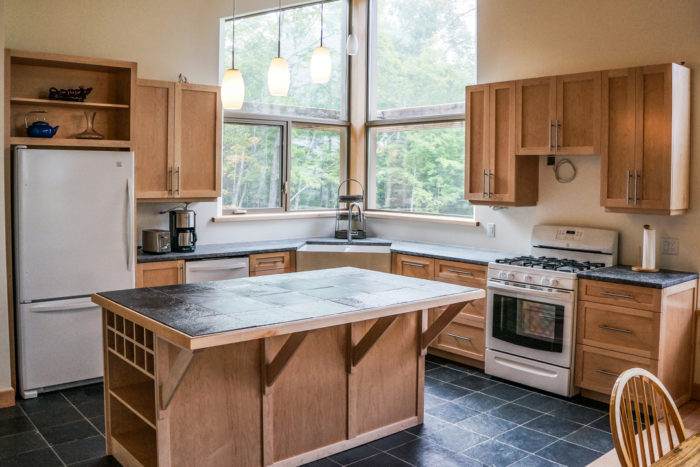
Image Credit: Craig Anderson
This is one of a series of posts by Craig Anderson describing the off-the-grid house he built with his wife France-Pascale Ménard near Low, Québec. Craig writes about the “Seven Hills Project” in a blog called Sunshine Saved. For a list of Craig’s previous posts, see the list of “Blogs by Craig Anderson” in the sidebar below.
In years past, the mechanical systems and appliances in off-grid homes looked quite different than those designed for typical grid-tied houses. Generating electricity was extremely difficult and expensive at the home scale, so there was much less electrification. Instead, off-gridders used other technologies like wood stoves, kerosene lamps, and propane-powered appliances.
One can still find most of these home systems, including such things as propane lighting and propane-powered refrigerators. However, these systems are made at such a small scale and are in such small demand that they are quite expensive and do not perform incredibly well. Thankfully, an off-grid house today can maintain essentially all the comforts of on-grid living, as long as one is careful about making choices.
Two trends have allowed this to happen. First, solar power generation and storage is falling quickly in price, and it is now possible to have a regular supply of electricity at a home for a manageable cost. Second are the large increases in efficiency of all the electronics used in our homes. The normal, high-efficiency, often Energy Star approved, appliances and other electronics of today use just a fraction of the power of their predecessors.
Put all of these trends together, and it is now possible to use all off-the-shelf products from standard stores, as long as the most efficient of available options are chosen. The one thing that is difficult to do with electricity in an off-grid home is heating. Whether it be home heating, water heating, the kitchen range, or a clothes dryer, all of these are energy hogs and not affordable in today’s off-grid home.
In our case, we use propane to do most of this heavy lifting (though I hope to eliminate the propane at some point in the future). Below is a run-down of all of the systems that we have put into our home.
Kitchen range
We have a propane range, one of the basic models that was available at the local Sears (the Kenmore 5.0 cu. ft. Freestanding Gas Range with variable self-clean, model #74132). This unit has five burners on top, and propane burners at both the bottom and top of the oven.
This unit does require some electricity for full functionality. The range has electronic sparkers to light the burners, though these can be lit with a match or lighter if there is no power. The oven, however, requires a larger and more constant supply of power, as a heating element stays on at all times when the oven is heating. I have not been able to find the exact power draw for the stove heating element, but I think that it is around 200 or 300 watts. It would have saved a bit of electricity if there were a pilot light inside the oven, but these models are getting harder to find and are apparently not always as safe as the electrically controlled ovens.
Refrigerator
A refrigerator is one of those modern conveniences that would be very difficult to live without. And with refrigerated and frozen foods, it isn’t possible to turn off the power when you are away unless you empty out the whole thing. As I mentioned above, one can run a refrigerator on propane, but these units leave something to be desired when compared to a typical fridge.
Thankfully, we produce enough electricity to keep a fridge powered. We have a Kenmore 596.6938, a 20-cubic-foot model rated to consume 459 kWh per year. There are a few fridges that have power consumption as low as 350 kWh/year (less than 1 kWh/day), but they were a bit small for a family that does some entertaining.
Dishwasher
We wouldn’t have needed a dishwasher necessarily, but it is a nice convenience. We picked up an Energy Star rated Kenmore model 630, which Energuide lists at 269 kWh/year in expected power use. We generally only run it when it gets full, and it requires approximately 1 kWh per load of dishes when run on “Eco” mode.
Clothes washer
We chose a high-efficiency front-loading washer, again by Kenmore. This is one of the more efficient models available. Front-loading washers tend to outperform top-loading models, and provide one additional benefit — an extra powerful spin cycle. By spinning at several thousand RPMs, the vast majority of water is pulled out of the clothes before one even takes them out of the washer. This allows very quick air-drying, hung either outside on a line or in the house on racks.
We decided that it would not be worthwhile to try to add a dryer. Electric units consume too much electricity, gas dryers are more expensive, and we already were getting most of the drying done by the high-speed spin cycle.
Air handling
In any tightly built house, one needs to provide for ventilation. In older and draftier homes, a lot of air leaks into and out of a house through little cracks around joints, windows, and doors, but with high- efficiency construction there is a strong risk of the air getting stale. Our home ended up very tight (see our past post on that topic here), so we needed mechanical ventilation.
This is accomplished with a heat-recovery ventilator (HRV) which serves two purposes. First, the HRV exhausts stale air from the house while bringing fresh air in. All sorts of gases can build up inside homes, from cooking, off-gassing from materials, even simple human habitation, and these are vented to the outside when bringing in fresh air.
Second, an HRV exchanges heat between the exhaust air and the incoming fresh air, using a heat-exchange core. This allows the home to hold onto more heat in the winter, and keep out some of the heat in the summer. We settled on the LifeBreath 155 Max, which is sized nicely to our air circulation needs, while consuming only 40 watts of power on the low setting.
Lighting
Just in the last three to four years, there has been a sea change in lighting, as LED technologies have become cost-competitive with compact fluorescents and incandescents. While still somewhat more expensive than these other choices, LEDs last much longer (with a service life often estimated at around 20 years), and consume only a fraction of the energy.
We put in all LED lighting to minimize electricity use. Some of it is in specialized fixtures, but most of it is screw-in or pin-type bulbs, and this was only a bit more expensive than other options available. When lighting up the house at night, the total lighting loads seldom exceed 100 watts.
Water heating
We use propane to do our domestic water heating, with an indirect water heater powered by our propane boiler (see the post about our heating system here).
A heating loop from our boiler goes to the water tank. A heat exchanger consisting of a set of copper coils containing the heated glycol pass heat to the domestic water in the tank. Because this setup uses a relatively powerful boiler when heating the water, it is actually able to provide continuous hot water for such things as bathing. The water heater is set up to take precedence over space heating, so there is always a good supply of hot water.
Phone and internet system
While it was appealing to have no phone or internet at our home in the woods, it wasn’t practical. Both my wife’s and my work depend on being internet-connected, and it’s often important to be able to make phone calls. However, since we are so far off the beaten path, we have no phone lines, and only a very weak cellular signal at our home. To remedy this situation, it took a few steps. The good news was the phone and internet systems combined require less than 10 watts to keep a constant and high quality connection.
To improve the cell phone reception, I set up a cellular signal booster, which consists of several parts. First, there is an antenna mounted to the outside of the house which is pointed at the nearest cell tower about five miles away. From this antenna, a coaxial cable is run into the home into a cell signal amplifier, which is a box about the size of a typical modem. This is then connected to an interior antenna. When one uses a cell phone, the signal is received by the interior antenna, passing through the amplifier and exterior antenna to communicate with the cell tower. This system actually works very well, bringing the signal from one that is so weak that calls often cannot be connected, up to a very strong signal (5 out of 5 bars of reception listed on the phone).
To have a ready internet connection, we connected a cellular modem. This works just like any other modem, but instead of connecting through telephone or cable wires, it communicates over the cellular network just like a smartphone. Our local phone provider has a ‘family plan’ for data sharing, which we now share between smart phones for myself and my wife, as well as with the wi-fi network created by the cellular modem. Data is more expensive this way than through a wired connection, but as long as we don’t use the network for high bandwidth activities such as video streaming, it works very well.
Weekly Newsletter
Get building science and energy efficiency advice, plus special offers, in your inbox.





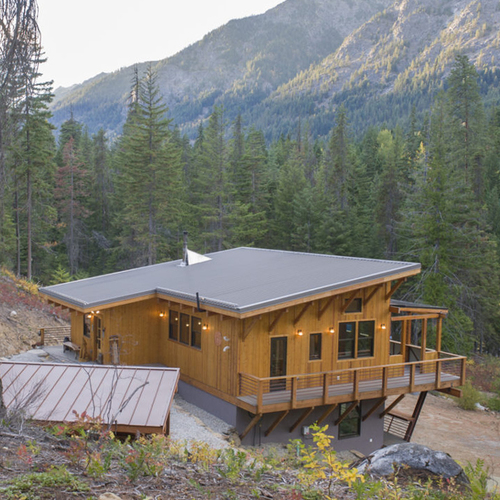
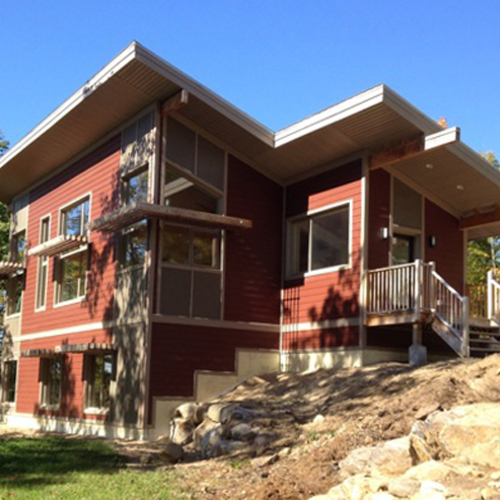
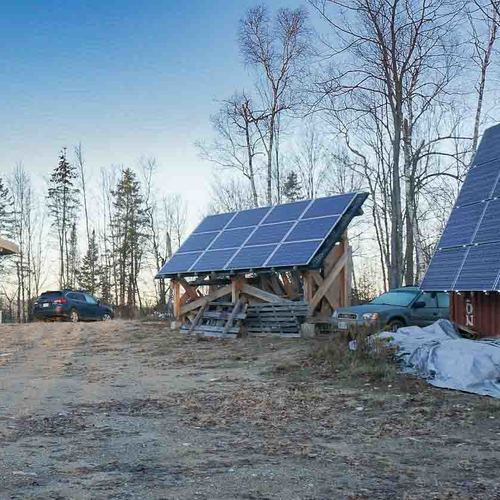
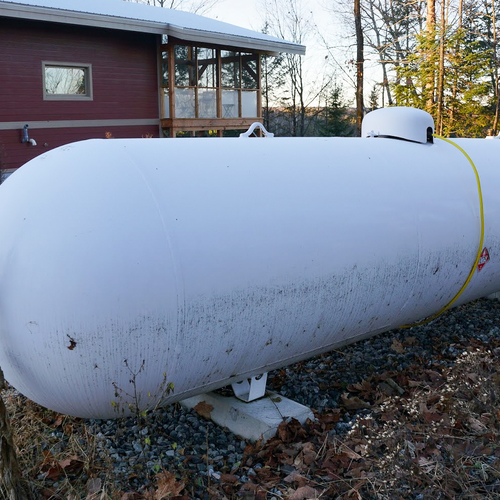






9 Comments
Gas ovens with an electric glow bar
Craig,
I'm really sorry to hear that you got snookered into buying a gas range with an oven that includes an electric glow bar that draws 200 to 300 watts continuously. What a bummer.
I've got a Premier P30S320BP kitchen range -- it has electronic ignition that operates off 120 volts AC. You have to plug in the range, but it usually draws 0 watts. The electronic spark only comes on briefly to light the pilot when you turn on the oven. Premier also offers battery sparkers -- for kitchen ranges with no cord at all.
Anyone who is new to off-grid living needs to study up before purchasing an appliance. An excellent source of reliable information is Backwoods Solar Electric. If you get a copy of their catalog, or visit their web site, you will be able to read their advice -- including this advice: "Beware of new gas stoves with a 500 watt electric glow bar in the oven that runs red hot whenever the oven is heating and consumes power rapidly! Peerless is one of the only brands available in the USA that uses gas-only for generating heat. Peerless Premier kitchen stoves offer two different options. Battery spark, Porcelain, models (“B” in the model number) use 8 “AA” batteries (located under the broiler drawer on the kick plate) to create the spark ignition for both cooktop and oven burners. Batteries will last approx. 4 years. The Pro Series models (model number begins with "P") feature a stainless steel finish, and also uses a AA battery pack to ignite the burners. A match can light the burners on any model; though reaching into the oven to manually light that burner takes a stretch."
Although Backwoods Solar doesn't mention the Peerless models that have 120 volts AC spark ignition, the rest of their advice is spot on.
Range hood data
Though I don't see one yet, it looks like you're installing a range hood, which is necessary. Is there any data on the energy penalty of constantly running an exhaust fan to get rid of CO2 and combustion humidity?
.
Range hood
Ah, you found the detail that reveals how old this picture is. Yes, we have had a range hood installed from soon after we moved in. Our architect, builder and I had discussed whether the HRV would provide enough air exchange, but it turned out that every gas burning appliance absolutely requires its own active venting to meet the LEED certification (we ended up LEED Gold). To answer your question, no, I don't have direct data on that, but it could be calculated. One could look at the cubic feet per minute of air that the exhaust fan actually moves, times the amount of energy lost per cubic foot of interior air, times the number of minutes per day that the fan is running. In practice, I don't think that energy penalty is very high. I would guess that the amount of heat exhausted is far less than the waste heat coming off the range when cooking. We notice that at all times of the year, when cooking and running the fan, that the entire upstairs space heats up rather than cooling down.
Response to Martin
Yes, in a perfect world we would have purchased an oven that did not have the electric glow bar, and instead simply used a sparker as the Peerless that you mention. At the same time, the amount of power that our range draws does not exactly break the bank when it comes to power consumption. While we do a lot of cooking, isn't very often that the oven needs to be on for many hours in a day. One other extenuating factor is that the model we did find was easily available at a standard local appliance store, and that convenience is worth something too - for access, service, etc. I do remain satisfied with the range that we chose, though if we had it to do over again, I certainly would take a look at the Peerless ranges.
I always wondered
I always wondered why my gas oven uses 350W, what is the purpose of the electric glow bar?
Response to Alan B
Alan,
To maintain a temperature close to the oven setting (for example, 350°F), the gas burner has to cycle on and off. Each time the burner turns on, it needs to be lit. The glow bar is a substitute for a traditional pilot light. Needless to say, using 350 watts continuously instead of a small pilot light isn't very smart if you live off-grid (and isn't particularly energy-efficient choice even if you are grid-connected, especially when compared to the Premier approach).
Stoves
We use both a peerless and conventional with glow bar. Sometimes we need both at the same time. But generally in dark days of winter we use the peerless exclusively and when we have over abundance (about 9 months a year) we use the glow bar. We are off grid with 12 kW PV and 40 kWh battery. Both ranges have full range hoods which we always use. Energy demand is small for fans, and important for air quality. Much of the year we also electrically heat water for coffee, use induction hot plates, electric rice cookers, microwave as well. Off grid does not have to be inconvenient anymore, with PV prices having fallen. Average residence population in winter is 16 adults.
Power off and gas stoves?
I'm certainly no expert in this field, but I was at one time the property manager for a resort. The very idea of manually lighting a gas stove during a power outage makes me worry because if you have no electricity you have no exhaust air. This is dramatically more important in a tight house. Gas stoves (fireplaces, water heaters...) are not 100% efficient, which means that if the burner is on you're adding carbon monoxide, nitrous oxide, formaldehyde and other gases into your breathable air. This can lead to long-term health effects and among other issues is a known asthma trigger. Sticking your head into a gas oven to baste the turkey? You may as well stay there. There are some studies that show that even a kitchen exhaust fan isn't enough to mitigate the health effects but I'll leave those arguments to the experts. If you have no way to vent, the only gas appliance you should be running during a power outage is an outdoor barbeque. The health department would have shut us down for pulling something like that.
Mike.
Response to Mike Nelson Pedde
Mike,
The discussion on this page concerns stoves installed in off-grid homes. No one is talking about operating a gas stove during a power outage.
I've lived in an off-grid house for 36 years, and I've never had a power outage (because my house, like almost all off-grid houses, has redundant power systems, including a gas-powered generator). Power outages are far more common for grid-connected houses than for off-grid houses.
Log in or create an account to post a comment.
Sign up Log in